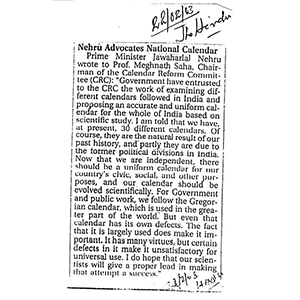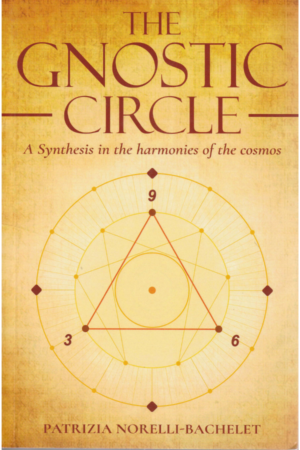Q&A with Patrizia Norelli-Bachelet
Director, Aeon Centre of Cosmology
Tamil Nadu, India
March 2009
Q. I have before me a letter written by Prime Minister Jawaharlal Nehru in 1953 to the Calendar Reform Committee. He wrote, ‘Now that we have attained independence, it is obviously desirable that there should be a certain uniformity in the calendar for our civic, social and other purposes and this should be based on a scientific approach to the problem…’ It’s been many years since this message was written, nothing has happened. What is your interest in bringing up this issue again?
A. It is not exactly that nothing happened. That Committee did indeed agree on a calendar for the nation; but in what concerns ‘other purposes’ the result was unfortunate. In the same letter Pandit Nehru remarks that there are some 30 calendars in use and that this causes a certain confusion. It was made worse confounded by the fact that there is no agreement on the actual starting point of the calendar year among Hindus, unlike for civic purposes with the government having adopted the calendar in use throughout the world.
I must clarify an important objection raised by certain champions of Hindu culture in this regard. They claim that this civic calendar is Christian and that therefore it should not be adopted by Hindus. Nothing could be farther from the truth. The universal calendar was adopted by Christians when Christianity came to occupy a position of power in the early part of the first millennium, simply because that solar calendar based on the Earth’s orbit of the Sun along the ecliptic was the only calendar used by the ancient world. In fact, rightfully speaking it should be labelled Vedic, – the Vedic Calendar.
Q. What do you base this statement on?
A. Similar to all ancient cultures in the Vedic Age, sages used the actual rhythms of the Earth as the basis for their calendar. For example, the balancing factor was the four Cardinal Poles – which never changes; as it was then, so it is today. There are verses in the Rig and Atharva Vedas which make this clear:
Twelve spokes, one wheel, navels three.
Who can comprehend this?
On it are placed together
Three hundred and sixty like pegs.
They shake not in the least.
(Rig Veda 1.154.48)
One is the wheel; the bands are twelve;
three are the hubs – who can understand it?
Three hundred spokes and sixty in addition
have been hammered therein and firmly riveted…
(Atharva Veda X, 8)
The most important portion of the above is ‘one is the wheel’(AV); and further, ‘they shake not in the least’(RV). The Rishi stating that the circle is one makes it clear that all measuring must be done on the backdrop of this single circle. That is the ecliptic within which the Earth and planets travel. Even the Nakshatras are to be measured in this single circle of 360 degrees and which we further divide into four quarters – two of which are the Equinoxes, and two the Solstices. The Nakshatras are simply one of the many divisions of that single circle (the ecliptic); they are based on the mean motion of the Moon: 13.20 degrees per day. These have been labelled the Mansions of the Moon when Al Biruni brought this knowledge from India to Arabia; and from there it passed on to Europe. This designation is still used in astrology today.
Basic astronomy gives very precise timings for Equinoxes and Solstices, as do certain ancient texts such as the Brihad Samhita. Two timings were especially important: the Equinox of March, and the Solstice of December. The former is the true beginning of the Vedic year – 21/22 March. That is the 0 degree of the ecliptic when days and nights are equal. The second, the December Solstice (Makar Sankranti) is even more important for Hindus and continues to be celebrated throughout the nation, though its current timing is woefully incorrect.
The Rishis emphasised only these two timings because getting them right would mean that all the rest would be accurate as well, – the Navaratri, for example, and all the other celebrations of Hindus. It may be claimed that being festivals based on the phases of the Moon different calculations and a different circle would be needed. This is not so. Just as the Veda states, the circle is one. Within that even the lunar phases are inserted, with the required intercalary addition to compensate for any discrepancy. However we study the matter we note that the degrees of this single circle are 360 ‘pegs’ set therein, and which we divide into 12 parts.
When the Rishi states, ‘they shake not in the least’, he or she is referring to the most important injunction of all. For the fact is the current Hindu calendar in use does indeed ‘shake’ insofar as its starting point, or ayanamsha, is not fixed, as would be the case for the universal calendar. It shifts constantly, with each passing minute and second in fact, unlike the true Vedic Calendar which does not shake ‘in the least’, even with the passage of thousands of years.
Q. Pandit Nehru encouraged scientists to lead the way in calendar reform, but you say that science itself has been the problem. What do you mean?
A. It is not the duty of scientists to interpret Vedic injunctions. This is not their domain. It is the duty of men and women versed in the language of cosmic harmonies based on direct yogic experiences, of the Vedic type, I must add. Clearly in the Committee for Calendar Reform in 1953, there was no such person. In my experience I have not come across anyone who has undergone a sadhana for this express purpose. The result is what we have today – a calendar that cannot unify 80% of the energies of the nation.
A scientist would not make any sense out of the Rig Veda verses I have quoted. He would not take them seriously since in the first place he does not believe that the ancients had knowledge of such matters. Remember that these verses were composed before astronomy became a separate discipline. In those days throughout the world it was simply astrology, jyotish, albeit quite different than the astrology practised today. That was ‘science’ and it was based on astronomical data which was easily verifiable by calculating the Equinox and Solstice. The tropical zodiac in use then is the same we use today. Its division into 12 parts is important to note, as the Vedic verses affirm. Those 12 parts/months must begin when day and night are equal based on the four balancing pillars of the ecliptic – the Cardinal Poles. Science will focus on the astronomy involved; it cannot be expected to deal with aspects of Yogic/Vedic knowledge. This is the domain of those who have undergone a certain discipline that reveals the higher issues involved. Since this discipline is very demanding, the Rishi asks, ‘Who can understand this?’ It would appear simple to understand, but the truth is otherwise – if not, the Vedic calendar would not have been discarded in favour of what is currently in use: the Nirayana system based on the constellations and not the tropical zodiac of the ecliptic, as in Vedic times. The result is the calendar confusion that plagues the Hindu Samaj today.
Q. The tropical zodiac with its four Cardinal Poles of Equinoxes and Solstices is the true Vedic measure of time. What do you base this statement on?
A. In the Veda there is no reference to a circle that is disconnected from the Earth’s rhythms. This same prescription is used in temple building to this day, based on the sacred scriptures. A Hindu temple is oriented to these Cardinal directions, similar to the Great Pyramid at Giza. Regarding the latter, it is astonishing to note the accuracy with which such a massive structure was built. This was many millennia ago, yet the Cardinal directions remain the same, then as now because, as the Rishi stated, ‘…the circle is one, it does not shake in the least’.
So, the Cardinal directions were fundamental. Spatially the temple is accurately aligned; however, when time has to be incorporated this is done based on the scientist’s understanding of the way measuring is to be done. The result is that time and space do not find their necessary harmony in Hindu Temples; and this is compounded year after year, day after day by that same system employed for all observances. While the spatial alignment may be correct, the time factor is another matter. Herein stands the difficulty. To rectify the situation bold measures must now be taken. If not, the ‘slippage of time’, as I call it, will continue; and with it the Dharma as well: we move farther and farther away from those Vedic roots.
Q. Most would disagree. The prevailing belief is that time is relative; therefore, how can what is ‘eternal’ (the Sanatana Dharma) be linked to what is ‘relative’ and impermanent?
A. Let me quote another verse from the Rig Veda. It is pertinent to your comment:
Certain eternal worlds…are these which have come into being,
their doors are shut to you (or opened) by the months and the years;
without effort one (world) moves in the other, and it is these that
Brahmanaspati makes manifest to knowledge.
RV, II.24.5.
Naturally these lines are difficult for the layman to understand, but, I repeat, not for one who has undertaken the Vedic ‘journey’ just as it is described in the Veda, based on the revolution of the Earth around the Sun, along the ecliptic within the tropical zodiac; above all the zodiac because that is where we find the secret language. The central protagonist of the Veda is the Year – the sacrifice lasting 12 months.
The Rishi is explicit in these verses: the doors of the months remain closed or are opened by the knowledge Brihaspati (Jupiter, known as the Guru in astrological lore) confers. Most important is mention of ‘eternal worlds’, and one moving into another ‘without effort’. Entrance into these ‘worlds’ is secured by the correct knowledge: that is, the right KEY that unlocks the doors (months). For this to occur the right time harmony of our solar system has to be the key to open those otherwise closed doors.
Today there is no such key available to worshippers; thus we witness the faithful flocking to temples according to the day and time prescribed by pundits in their various almanacs – each one advocating a different time, it is to be noted. But, lamentably, based on these mis-measures there is no door before them to open! Time has slipped by, though none, not even the pundits are aware. Translated into practical terms, the result is that there is no unifying element for those COLLECTIVE energies. The individual devotee may well receive the blessings of the deity because of his or her fervour and belief, but that will not ‘unlock the door’ no matter how much devotion is poured out to the Goddess. Brihaspati cannot ‘make manifest’ the higher knowledge that can truly replenish, and restore a unifying PURPOSE in the Hindu Samaj. As it is, the Sanatan Dharma is losing ground to other less mature, less profound faiths.
If this unifying measure were to come into being, the weaknesses presently afflicting the community would be overcome. There would be a renaissance of immense significance and vigour.
Q. Where exactly has science gone wrong in this matter?
A. I can be very specific: the grave error for which reason we cannot experience a ‘circle that shakes not’ is because science disregarded the Earth’s own contribution to the harmony of the System.The ecliptic journey of 12 months through the tropical zodiac was displaced in favour of a projection well beyond our solar system to the constellations. Out there, hundreds of light years away from our planetary base science determined the start of the year. Moreover, it determined for the Hindu Samaj that this was the true measure to follow, requiring, however, a rectification from time to time based on certain calculations so that the ayanamsha or zero starting point of that distant constellation of stars would be ‘scientifically correct’. No thought was given to 1) this ayanamsha is almost impossible to determine with precision, hence resulting in serious differences among the pundits, and 2) that ayanamsha is therefore NOT STABLE as seen from the Earth, making therefore a mockery of the Rishi’s express statement: It shakes not!
Q. You mentioned the Makar (Capricorn) Sankranti as being ‘woefully incorrect’. Can you explain? In what specific way is it ‘incorrect’?
A. By its very name this ‘gateway’ (Sankranti) is connected to the zodiacal sign Capricorn (Makar). The question is, which Capricorn? Using the current Nirayana system, the sign Capricorn referred to is Capricorn of the constellations. This is quite different than what is meant when the system the Rishis espoused is employed for calculating this most important of all Hindu observances. I say most important because the entire destiny of India, old and new, is encapsulated in that special sign of the 12.
I reproduce below the symbol-map of India with the Capricorn hieroglyph superimposed on it. This is of course Akhand Bharat and predates contemporary boundaries drawn on this particular segment of the Earth’s geography. Indeed the origins of the glyph are unknown since it extends very far back in time probably to prehistory. I have written extensively on this subject, with this symbol-map as background, because the relevance of the sign can be verified geographically with great precision. However, even without this ‘proof’ all astrologers throughout the world consider Capricorn to be the astrological ruler of India.

From: The New Way, Volume 1, p.154, Aeon Books
But there is more. There is a time factor involved along with the spatial measure. We use the Earth’s longitude to ‘locate’ the sign Capricorn. This, most interestingly, gives us the precise ‘location’ of Capricorn on the globe. Most astonishing of all, it coincides with the beginning of the Indian landmass as indicated in the map-symbol. The point I am making is to demonstrate the singular importance of Capricorn (Makar) for India. I repeat, the full destiny of the nation can be understood by a penetrating analysis of what this sign really signifies; it is the most secret and sacred of all. But we have the Rig Veda itself that confirms its importance. Though penned thousands of years ago, the Rishis located the victory of the Aryan Warrior to be in this very sign of the twelve, the 10th month (calculated from the first, the March Equinox). Note that it was not in just any period, any month: it was the tenth. And that is the sign Capricorn.
If we use the constellations to locate this section of the circle, the result is what we have today: the sign Makar does not begin when it should for Hindus. It is 23 days AFTER the onset of the sign. Capricorn in all ancient civilisations, foremost of all the Vedic, begins (the sankranti or gateway) at the exact time of the December Solstice, the shortest day of the year. For this very reason Bhisma chose this date to leave this plane. There is a very deep purpose in this timing to coincide with the shortest day. I have written extensively on this subject and need not repeat myself here. Suffice to state that by positing this gateway 23 days after it actually occurs, that ‘door’ has passed us by. The result is that the most important of all Vedic injunctions – the 9 becomes the 10 – cannot be realised. It is as simple as that.
This is of course relevant to the individual, but even more so for the Hindu Samaj. Collectively this shortest day should be observed if the passage ‘the 9 becomes the 10’ is to bear any impact for the entire nation. Certainly Bhisma would have had a hard time making this passage based the current Nirayana system!
My point is that when the symbol-map is revealed, as it was in 1974, we know that the most important period of India’s history for thousands of years has come to the forefront. It is now, in our very times, that everything Capricorn signifies in the nation’s destiny can reach fulfilment. But as it stands, this cannot happen; and we see the results all around us. It can happen only when the correct ‘key’ is inserted and the tenth month does indeed stand before us, both individually and collectively. Therefore I have put so much energy into revealing these deep aspect’s of India’s destiny – aspects which have been set in motion thousands of years ago. I do so in order to drive home the point that we do run the risk of missing the moment. Therefore I invite pundits to discuss this matter and reach a conclusion. I am ready to present my arguments. I am ready to listen to theirs. Thereafter, let the community decide.


